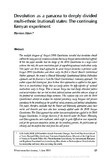| dc.description.abstract | The multiple designers of Kenya’s 2010 Constitution intended that devolution should
address the many years of economic exclusion that many Kenyan communities had suffered.
While this paper concedes that the design of the 2010 Constitution to a large extent
achieves this role, the same constitution fails at engendering national multi-ethnic unity.
This paper uses three broad approaches to assess Kenya’s devolution experiment under
Kenya’s 2010 Constitution and ethnic unity: the first is Daniel Posner’s Institutional
Politics approach, the second is Donald Horowitz’s Constitutional Ethnic Federalism
approach, and the final one is Yash Pal Ghai’s Constitutional Autonomy approach. The
author argues that limiting our focus to these three approaches as applied in this paper,
there is no constitutional design that can easily achieve the lofty objective of national
multi-ethnic unity in Kenya. This is because Kenya has had deeply ethnicised politics
and social relations that are tied to ethnic political patrons and elites who are always at
the forefront of constitutional design outcomes. This explains why even with the 2010
Constitution’s attempt to weaken the imperial presidency, many Kenyans still perceive
ascendancy to the presidency as the zenith of social, economic, and political actualisation.
The paper, therefore, concludes that the Posner and Horowitz approaches above have
merits and demerits and have also been variously applied under the 2010 Kenyan
Constitution. The Ghai approach has neither been contemplated nor applied in the 2010
Kenyan Constitution. It emerges that even if the demerits under the Posner, Horowitz,
and Ghai approaches were eradicated, which might be quite difficult or even impossible,
and yet the zero-sum competitive politics for the presidency persists, the politicisation of
ethnicity and the conflicts that stem from this will persist. | en_US |

